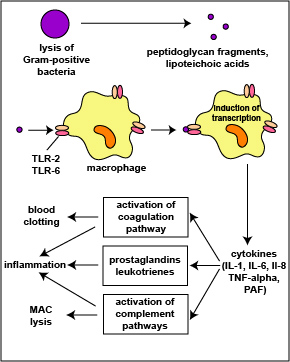
The lysis of gram-positive bacteria causes them to release peptidoglycan fragments and lipoteichoic acids from their cell wall. These cell wall components, in turn, bind to toll-like receptors such as TLR-2 and TLR-6 that are specific for these cell wall components and are found on the surface of body defense cells called macrophages. This triggers the macrophages to release various defense regulatory chemicals called cytokines, including IL-1, IL-6, IL-8, TNF-alpha, and PAF. The cytokines then bind to cytokine receptors on target cells and initiate inflammation and activate both the complement pathways and the coagulation pathway. These gram-positive cell wall components can also bind first to binding proteins circulating in the blood that subsequently carry them to CD14 molecules on the macrophages.
(TLR, toll-like receptor; IL-1, interleukin-1; IL-6, interleukin-6; IL-8, interleukin-8, TNF-alpha, tumor necrosis factor-alpha; PAF, platelet-activating factor; MAC, membrane attack complex.)
Illustration of Function of The The Effects
of Peptidoglycan Fragments
and Lipoteichoic Acid Released During Gram-Positive Infections .jpg by Gary E. Kaiser, Ph.D.
Professor of Microbiology,
The Community College of Baltimore County, Catonsville Campus
This work is licensed under a Creative Commons Attribution 4.0 International License.
Based on a work at https://cwoer.ccbcmd.edu/science/microbiology/index_gos.html.
Last updated: August, 2019
Please send comments and inquiries to Dr.
Gary Kaiser